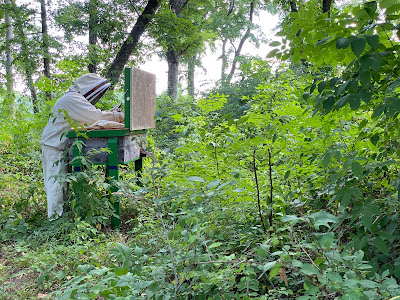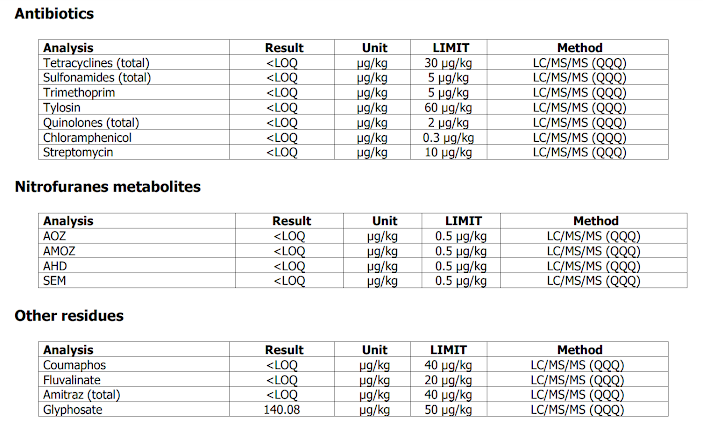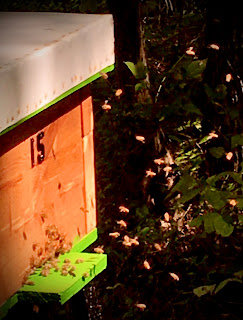Keeping Bees on Every Farm the Easy Way
Published in Farming Magazine, Spring 2019,Vol.19, Issue 1,No. 73
I live in the Kurdistan Region of Iraq, but my farm is in southcentral Kentucky. I am also a beekeeper, but my bees are almost 6400 miles away. Yet I keep bees, I keep them responsibly, and I do not really have to worry about over-wintering, frequent inspections, and all the other beekeeping “duties” that make conventional beekeeping such an onerous and expensive task. In fact, my guidebook for beekeeping was written in the 19th century by a French beekeeper, Georges de Layens, who developed a hive known today as the “Layens Hive.” De Layens describes how he set up beeyards that only had to be visited twice a year, spring and fall, to inspect them and harvest honey, both of which only took a few minutes.
As a small-scale, organic farmer whose entire 15-acre farm is dedicated to bees, and whose apiary consists at present of about a dozen hives, I have come to appreciate the powerful role that bees play not only in nature, but on the farm - every farm. In fact, in the 19th and early 20th centuries, it was fairly standard in Europe and the United States for virtually every farm to have bees as part of its diversified livestock, as they were vital to the pollination of fruit trees, gardens, flowers, hayfields, and many vegetable crops. They were also a vital source of nature’s healthiest sweetener, but even more so, they were a cash crop for the farm that women often managed, just like eggs and fresh vegetables for the farm stand or market. In fact, beekeeping was mainly “women’s work” in much of the 19th century as many farms only had a few hives.
Now, though, the role of bees as nature’s best pollinator has become more widely appreciated as we have seen a huge decline in the wild bee population due to chemical-based farming, GMO crops, and other non-natural practices in agriculture that skewed the natural order. Large-scale migratory beekeeping, in which millions of beehives are trucked around the country to pollinate almonds, apples, blueberries, squashes, clover, pumpkins, cranberries, etc., before being left for the winter in warm Southern states, depends on hives designed for easy movement, packing on pallets, and handling with forklifts, the same designs that have become standard for even the hobbyist beekeeper wanting one hive in the backyard.
Sadly, the methods of beekeeping promoted by today’s local bee clubs, regional apicultural societies, beekeeping magazines, and the beekeeping catalogs is almost entirely based on this model of commercial, migratory beekeeping. While it may work for the large-scale, commercial operation, it is no more suitable for the hobbyist beekeeper than a huge tractor and cultivator are suitable for the small, organic home garden. For the small-scale beekeeper, though, there is a much better way and it is a way that is cheaper, easier, requires less work, produces better honey, and is healthier for both the bees and the beekeeper.
In my experience, the conventional approach to beekeeping would simply not allow me to work in Iraq while keeping bees in Kentucky. In fact, conventional beekeeping seemed to be so complicated and unnatural that I resisted using that approach even before I bought my first hive! As a result, my first hive ended up being a top bar hive as that seemed more “natural.” The conventional approach requires too many inspections, too much micromanaging of the beehives, too many chemical inputs, and frankly too much expense for it to be worthwhile on a small scale. In fact, one might even argue that my needs in beekeeping are much like those of most small farmers who use organic and sustainable farming methods, believe nature’s ways should be respected as much as possible, and who want to commit as little time and resources to the apiary as they can. In fact, I believe strongly that EVERY farm should have at least two or three beehives on it and even for people living in town, a single hive in the backyard near the garden would do a lot of good.
As you may have guessed by now, I follow “treatment-free” beekeeping practices. I do not feed my bees sugar or other foods, I do not treat for mites or small hive beetles, or anything else, but I leave it to my bees to survive and evolve to meet the challenges of their area so they can evolve to fit best the climate and pests prevalent in my corner of Kentucky. When I recently returned to my apiary from Iraq after being absent for several months, all the hives were doing well.
However, the treatment-free approach might not be right for everyone. If you elect to go the conventional route, that is your decision, but you should consider alternative methods as well. If your apiary is near other conventional beekeepers or a commercial operation, you may decide you have no choice but to treat. My apiary is isolated from others so my bees are in a much better position to evolve on their own. However, if other conventional beekeepers are within a couple miles of your apiary, then you may find you need to treat. At the end of the day, though, it’s whatever works best for you! For me, treatment free has proven to be a good approach, in part because of my isolation and the lack of other beekeepers in the near area. Yes, I’ve lost hives, but so have conventional beekeepers! Whichever approach you choose, however, the choice of hives you adopt is a separate issue and any type of hive will work with either approach.
Although I loved my top bar hive, and found other hive versions interesting, I eventually settled on the “Horizontal Langstroth Hive” and the “Layens Hive” for my apiary. These versions both use horizontal arrangements for the frames, are one storey only, and allow the bees to live and manage their hive in a much more natural manner.
Dr. Leo Sharashkin, a Russian immigrant who came to the States for university studies (eventually getting his PhD in Forestry from the University of Missouri), promotes these types of hives that are very common in Russia and Europe. The beauty of these hives is that you can build them yourself, they are cheap, they require little maintenance, and the bees are healthier and do not need to be disturbed as much, especially if you use treatment-free methods of beekeeping.
I build my own hives from scratch, I catch wild bees as much as possible, I do not treat or feed my bees in any way, and I really need to inspect them only once a month during the warm months, if even that, and I harvest honey twice a year. Does this sound too good to be true? It’s not! In fact, the honey harvested from just one hive in one of the two honey harvests may well be enough to pay for all the materials used to build three hives and to catch the wild bees.
The horizontal Langstroth hive uses the conventional “Langstroth deep” frames that most conventional beekeepers use, about 30 frames arranged in one layer in a thick-walled, horizontal box. For the Layens hive, I build my own frames, which are narrower and deeper. I also build my own swarm traps to catch free bees in the spring, and none of this requires more than the most basic carpentry skills. My horizontal hives are built of 1.5 inch thick cedar lumber from an Amish sawmill, or 2x10 pine planks from the hardware store. It’s very possible that wood from a recycling center or the scrap pile in the barn might be used as well so they are truly free. The carpentry work required is very simple, so even the most modestly skilled hobbyist should be able to make everything necessary. While I have bought bees, I have also caught swarms and prefer them because they are free and stronger than purchased bees.
Catching swarms is a bit of an art in itself. In reality, you may simply be catching the bees that swarmed from another beekeeper’s apiary, but the fact that they survived the winter and were strong enough to swarm means they are good stock that should serve you well, much better than the bought bees from a commercial supplier. A simple box with five to seven frames, placed a few feet up in a tree on the edge of a woods in April or May, can yield a nice swarm of bees that will get your apiary off to a good start! Best to place two or three traps around, however, or get a swarm from someone else who catches swarms, as some years the number of swarms may be low.
In addition to using Layens and Horizontal Hives, which are both much more in tune with the life of bees and their natural practices, I also use treatment-free practices which do not permit the use of antibiotics or miticides or other chemical treatments in the hive and I do not feed them sugar or anything else except their own honey. For the hobbyist beekeeper, this is a much simpler approach and it’s actually better for the bees - we let natural selection produce a stronger race of local bees. Yes, a colony may die off, but the ones that survive are stronger and will produce a better line of locally-adapted bees. Yes, they may get mites and small hive beetles, but those pests can be tolerated by strong colonies. This is the animal husbandry part of beekeeping that is much more doable when avoiding modern commercial methods that are really only applicable to large-scale operations.
For those who elect to follow conventional beekeeping practices with sugar feeding, antibiotics, and other treatments, they will still find that the horizontal hives offer better protection for the bees and a more natural environment in which to live and are much easier to maintain. Therefore, even if I elected to go the conventional route, the use of the horizontal hive can still make beekeeping much easier and more enjoyable.
What about over-wintering? Commercial hives are thin-walled and need to be wrapped and insulated in most places, but mine are twice as thick - 1.5 inches thick of pine and cedar. They naturally insulate the hive from the heat of summer and the cold of winter. “Winterizing” my beehives takes all of five minutes and costs nothing - I simply reduce the entrances to keep out mice and excessive cold air and check to make sure they have plenty of their own honey to eat over the winter. Conventional beekeepers typically lose a third or even half (or more) of their hives over the winter, but I might lose one out of six, at most. And those are quickly replaced with free bees from a swarm trap or a split from my own bees!
Finally, I harvest the most wonderful, raw, chemical-free honey ever from my hives which are located in a five-acre forest and surrounded by many acres of wildflowers and clovers. The pollen sources are highly diversified and I sell it for $20/lb; it sells fast because people can taste the difference and it’s a health food, not just a sweetener! Honey from treated hives will typically sell for much less - $8/lb as of this writing, so even if the harvest is less, the added value compensates in income. There is a real difference between treatment-free honey from diversified nectar and pollen sources and the stuff that comes from the big-box store produced by large-scale, migratory beekeeping operations. It is truly local, it’s as pure as can be, and it’s chock-full of pollen and other healthy ingredients because it’s raw, lightly filtered, never heated, and from a hive that is free of all chemicals and sugar. You can produce this, too, on your farm or garden plot!
So if you want to help your environment, get free honey that is local, healthy, and tastes amazing, and you want the satisfaction that comes from building your own hives and saving a lot of money, then using Layens and Horizontal Hives might be the best option for you! Every farm and every garden should have bees, so if conventional beekeeping is too complicated and expensive for you as a small-scale hobbyist, then consider this option. I can tell you from experience that it works great!


